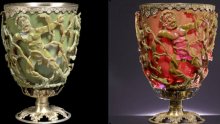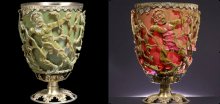 September 9th, 2013 | by Brittany M. Garcia
September 9th, 2013 | by Brittany M. Garcia
The Lycurgus Cup is a Roman glass cage cup, or diatretum, made of dichroic glass. This means that the properties of the glass allow it to change color depending on which angle light is shown through. If lit from behind the glass turns red and if lit form the front it turns green. The cup depicts the ancient Greek myth of the Thracian King Lycurgus. Lycurgus was fated a horrible death by Dionysus who cursed him for banning his religion and imprisoning his followers. There are several variation of this myth, but the reference seen on the cup (Lycurgus trapped in wine vines) is not a common variation. However, there is a satyr and a figure believed to be Dionysus (due to panther [Dionysus' patron animal] and the thyrsus [a staff with a pine cone tip carried by his followers]) who are expressing angry gestures.
The Lycurgus Cup is a rare item from history, whose use is still unknown and highly speculated. It has been thought to have been used in the rites of Bacchus (Dionysus Roman counterpart). However, this cannot be proven. Coincidentally, the Historia Augusta records the gift of two dichroic cups from Emperor Hadrian to his brother-in-law Servianus via a letter. Perhaps, this may have been one of them.
 The British Museum acquired the cup in 1950′s, but it wasn’t until the 1990′s that they understood its properties. Researchers analyzed broken fragments of the cup until they discovered that the Romans were nanotechnology pioneers. The glass effect of the Lycurgus Cups was achieved by making the glass with minutely ground gold and silver dust. The size of these particles of silver and gold are only about 50 nanometers across (less than one-thousandth the size of a grain of table salt) and required a transmission electron microscope to be seen. Thus, it is highly impossible that Roman artists made these minute silver-gold alloy dust particles for this size of cup; therefore, these particles must have been added in large quantities to even large amounts of glass-melts. Thus, there may have been other dichroic glass items made from the same glass-melt as the Lycurgus Cup.
The British Museum acquired the cup in 1950′s, but it wasn’t until the 1990′s that they understood its properties. Researchers analyzed broken fragments of the cup until they discovered that the Romans were nanotechnology pioneers. The glass effect of the Lycurgus Cups was achieved by making the glass with minutely ground gold and silver dust. The size of these particles of silver and gold are only about 50 nanometers across (less than one-thousandth the size of a grain of table salt) and required a transmission electron microscope to be seen. Thus, it is highly impossible that Roman artists made these minute silver-gold alloy dust particles for this size of cup; therefore, these particles must have been added in large quantities to even large amounts of glass-melts. Thus, there may have been other dichroic glass items made from the same glass-melt as the Lycurgus Cup.
Source: www.ablogabouthistory.com

|
The Visioneers: How a Group of Elite Scientists Pursued Space Colonies, Nanotechnologies, and a Limitless Future
Book (Princeton University Press)
|
The future is very bright and things
by formerspookAre getting better. And, more things are now possible than at any other time in human history. Right now we have the knowledge that enables people in the USA to live long, healthy, active lives. Many of us, however, ignore what is already known.
Over the next 10 years, the biotechnology revolution will find cures for most of the diseases that have plagued mankind, followed by the nanotechnology revolution that will allow us to maintain excellent health and will lead to radical life extension.
We continue to educate ourselves in the old way. Application of technology to the field of education is overdue
I don't understand the Big Bang theory but I
by phylumDon't have to accept it either. I stand on the sidelines watching what science has to offer for today. Either I will be interested in it or not.
My enjoyment of science is futurism and nanotechnology. Long after everyone in this forum is long dead, forward 500 years from now, computers will be seen only in history books like spinning wheels are in history books now.
In the future, our minds will be implanted with every need to have satisfied. I cannot back up what I say now as there are intermediate advancements in science by a thousand fold that I cannot predict so I have nothing to go on as an explanation.
Doode....
by lions_in-snowAt the onset of the twenty-first century, humanity stands on the verge of the most transforming and the most thrilling period in its history. It will be an era in which the very nature of what it means to be human will be both enriched and challenged, as our species breaks the shackles of its genetic legacy and achieves inconceivable heights of intelligence, material progress, and longevity.
For over three decades, the great inventor and futurist Ray Kurzweil has been one of the most respected and provocative advocates of the role of technology in our future. In his classic The Age of Spiritual Machines, he presented the daring argument that with the ever-accelerating rate of technological change, computers would rival the full range of human intelligence at its best
Nanotubes Increase Solar PV Conductivity 100 Million-Fold — Sourceable
Carbon-based nanostructures are already being used as materials in solar cells with increasing frequency, yet their ability to enhance electrical performance has thus far been hampered by limited ability to assemble orderly networks using the materials.

|
A Crisis of Faith: Atheism, Emerging Technologies and the Future of Humanity
Book (Bookshaker)
- Used Book in Good Condition
|

|
Future Trends in Microelectronics: Reflections on the Road to Nanotechnology (Nato Science Series E: (closed))
Book (Springer)
- Used Book in Good Condition
|
|
|
Whatever happened to cotton? Jim Thomas looks back from a brave new nanotech world at the fabric of history.(FUTURE FABRICS): An article from: New Internationalist
Book (Thomson Gale)
|

|
The Transhumanist Reader: Classical and Contemporary Essays on the Science, Technology, and Philosophy of the Human Future
eBooks (Wiley-Blackwell)
|
 September 9th, 2013 | by Brittany M. Garcia
September 9th, 2013 | by Brittany M. Garcia The British Museum acquired the cup in 1950′s, but it wasn’t until the 1990′s that they understood its properties. Researchers analyzed broken fragments of the cup until they discovered that the Romans were nanotechnology pioneers. The glass effect of the Lycurgus Cups was achieved by making the glass with minutely ground gold and silver dust. The size of these particles of silver and gold are only about 50 nanometers across (less than one-thousandth the size of a grain of table salt) and required a transmission electron microscope to be seen. Thus, it is highly impossible that Roman artists made these minute silver-gold alloy dust particles for this size of cup; therefore, these particles must have been added in large quantities to even large amounts of glass-melts. Thus, there may have been other dichroic glass items made from the same glass-melt as the Lycurgus Cup.
The British Museum acquired the cup in 1950′s, but it wasn’t until the 1990′s that they understood its properties. Researchers analyzed broken fragments of the cup until they discovered that the Romans were nanotechnology pioneers. The glass effect of the Lycurgus Cups was achieved by making the glass with minutely ground gold and silver dust. The size of these particles of silver and gold are only about 50 nanometers across (less than one-thousandth the size of a grain of table salt) and required a transmission electron microscope to be seen. Thus, it is highly impossible that Roman artists made these minute silver-gold alloy dust particles for this size of cup; therefore, these particles must have been added in large quantities to even large amounts of glass-melts. Thus, there may have been other dichroic glass items made from the same glass-melt as the Lycurgus Cup.








